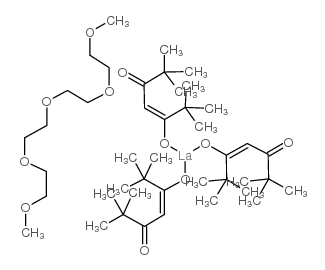tris(2,2,6,6-tetramethyl-3,5-heptane-dionato)lanthanum tetraglyme adduct
Modify Date: 2024-01-04 09:39:12

tris(2,2,6,6-tetramethyl-3,5-heptane-dionato)lanthanum tetraglyme adduct structure
|
Common Name | tris(2,2,6,6-tetramethyl-3,5-heptane-dionato)lanthanum tetraglyme adduct | ||
|---|---|---|---|---|
| CAS Number | 151139-14-9 | Molecular Weight | 910.98600 | |
| Density | N/A | Boiling Point | 125ºC 0,1mm | |
| Molecular Formula | C43H79LaO11 | Melting Point | 59ºC | |
| MSDS | N/A | Flash Point | N/A | |
| Name | tris(2,2,6,6-tetramethyl-3,5-heptane-dionato)lanthanum tetraglyme adduct |
|---|---|
| Synonym | More Synonyms |
| Boiling Point | 125ºC 0,1mm |
|---|---|
| Melting Point | 59ºC |
| Molecular Formula | C43H79LaO11 |
| Molecular Weight | 910.98600 |
| Exact Mass | 910.46900 |
| PSA | 125.05000 |
| LogP | 9.36650 |
|
Section 1: Product Identification Chemical Name:Tris(2,2,6,6-tetramethyl-3,5-heptanedionato)lanthanum (III)tetraglyme adduct (99.9%-La) (REO) CAS Registry Number:151139-14-9 Formula:La(C11H19O2)3.CH3(OCH2CH2)4OCH3 EINECS Number:none Chemical Family:metal beta-diketonate complexes Synonym:Dipivaloylmethane, lanthanum complex, tetraglyme adduct
Section 2: Composition and Information on Ingredients IngredientCAS NumberPercentACGIH (TWA)OSHA (PEL) Title Compound151139-14-9100%no datano data Section 3: Hazards Identification Emergency Overview:May be irritating to eyes, skin and respiratory tract. Harmful if swallowed Primary Routes of Exposure:Ingestion, inhalation Eye Contact:May cause slight to mild irritation of the eyes. Skin Contact:May cause slight to mild irritation of the skin. Inhalation:May cause irritation to the nose, mucous membranes and respiratory tract. Ingestion:No information available on the effects of ingestion. Acute Health Affects:May be irritating to skin, eyes and respiratory tract. Chronic Health Affects:No information available on long-term chronic effects. NTP:No IARC:No OSHA:No SECTION 4: First Aid Measures Immediately flush the eyes with copious amounts of water for at least 10-15 minutes. A victim may need Eye Exposure: assistance in keeping their eye lids open. Get immediate medical attention. Wash the affected area with water. Remove contaminated clothes if necessary. Seek medical assistance if Skin Exposure: irritation persists. Remove the victim to fresh air. Closely monitor the victim for signs of respiratory problems, such as difficulty in Inhalation: breathing, coughing, wheezing or pain. In such cases seek immediate medical assistance. Seek medical attention immediately. Keep the victim calm. Give the victim water (only if conscious). Induce Ingestion: vomiting only if directed by medical personnel. SECTION 5: Fire Fighting Measures Flash Point:no data Autoignition Temperature:none Explosion Limits:none Extinguishing Medium:carbon dioxide, dry powder or foam If this product is involved in a fire, firefighters should be equipped with NIOSH approved positive pressure Special Fire Fighting Procedures: self-contained breathing apparatus and full protective clothing. Hazardous Combustion andIf involved in a fire this material may emit toxic organic fumes. Decomposion Products: Unusual Fire or Explosion Hazards: No unusual fire or explosion hazards. SECTION 6: Accidental Release Measures Small spills can be mixed with vermiculite, sodium carbonate or other suitable non combustible adsorbent and Spill and Leak Procedures: swept up. SECTION 7: Handling and Storage Handling and Storage:Store in a cool, dry place in a tightly sealed container. SECTION 8: Exposure Controls and Personal Protection Eye Protection:Always wear approved safety glasses when handling a chemical substance in the laboratory. Skin Protection:Wear protective clothes and gloves. Consult glove manufacturer to determine the proper type of glove. Ventilation:Material may form a fine dust. If possible, handle the material in an efficient fume hood. If ventilation is not available a respirator should be worn. The use of respirators requires a Respiratory Respirator: Protection Program to be in compliance with 29 CFR 1910.134. Ventilation:Material may form a fine dust. If possible, handle the material in an efficient fume hood. Additional Protection:No additional protection required. SECTION 9: Physical and Chemical Properties Color and Form:white to pale-yellow xtl. Molecular Weight:688.72(911.00) Melting Point:59° Boiling Point:125°C /0.1mm Vapor Pressure:no data Specific Gravity:no data Odor:none Solubility in Water:insoluble SECTION 10: Stability and Reactivity Stability:air and moisture stable Hazardous Polymerization:no hazardous polymerization Conditions to Avoid:none Incompatibility:strong oxidizing agents Decomposition Products:carbon dioxide, carbon monoxide, lanthanum salts and organic fumes. SECTION 11: Toxicological Information RTECS Data:No information available in the RTECS files. Carcinogenic Effects:no data available Mutagenic Effects:no data available Tetratogenic Effects:no data available SECTION 12: Ecological Information Ecological Information:No information available SECTION 13: Disposal Considerations Disposal:Dispose of according to local, state and federal regulations. SECTION 14: Transportation Shipping Name (CFR):Non-hazardous Hazard Class (CFR):NA Additional Hazard Class (CFR):NA Packaging Group (CFR):NA UN ID Number (CFR):NA Shipping Name (IATA):Non-hazardous Hazard Class (IATA):NA Additional Hazard Class (IATA):NA Packaging Group (IATA):NA UN ID Number (IATA):NA SECTION 15: Regulatory Information TSCA:Not listed in the TSCA inventory. SARA (Title 313):Title compound not listed. Second Ingredient:none SECTION 16 - ADDITIONAL INFORMATION N/A |
| Risk Phrases | 36/37/38 |
|---|---|
| Safety Phrases | 26-36/37/39 |
| tris(2,2,6,6-tetramethyl-3,5-heptanedionato)lanthanum(iii)tetraglyme adduct |
| tris(2,2,6,6-tetramethyl-3,5-heptanedionato)lanthanum (iii) tetraglyme adduct (-la) (reo) |